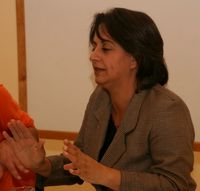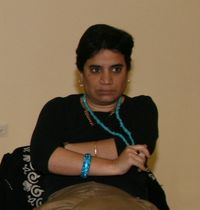Home > Oasis of Peace > Projects & Outreach > Doumia-Sakinah: The Pluralistic Spiritual Centre > Dirasat - Scripture and social transformation: the first two (...)
{Dirasat} - Scripture and social transformation: the first two meetings
Thursday 10 January 2008

An Interfaith study on the path to political justice
This report is an overview of the program, with short reports on the first and second seminars (November 22, 2007 and December 13, 2007).
Overview
With this program, Doumia Sakinah, the Pluralistic Spiritual Center of the Arab-Jewish village of Neve Shalom Wahat Al Salam invites Jews, Christians and Muslims to study their respective sacred texts together in an environment committed to political change and social transformation.
When Neve Shalom Wahat al-Salam’s founder, the Dominican monk Bruno Hussar described his vision of the spiritual center he said that it should be “accessible to all, believers and non-believers alike," for meditation, introspection, and prayer”.
Dirasat, a new program of inter-religious study, sustains and expands on this foundation. The Arabic word dirasat (studies) hails from the same Semitic root (drs), that yields the Hebrew word drash, (interpretation). The program offers traditional and secular Jews, Christians and Muslims access to the text and tradition of the religious “other”. Studying together means also to re-learn and re-understand, and reinterpret, the texts of one’s own tradition.
In our program we pay special attention to the challenged identity of minority groups within each society. This adds great depth to the pluralistic approach by orienting it in two directions at once – outward to the other national group, and inward to minority groups within one’s own society and religion. The marginalized groups – including Palestinian Christians, Reform Jews, and Sufi Muslims, and women in all denominations — are religiously disadvantaged in Israel in various ways. Empowering these groups to work together will leverage their tremendous untapped potential in the quest for peace and justice for all Jews and Palestinians.
The framework of the seminars
During the 2007-2008 academic year, we will hold six seminars - one every month - and a conference in June 2008.
The seminars discuss political/social issues within each faith tradition and between them. They refer mainly to the three main faiths of the region, Judaism, Christianity and Islam.
The lectures are presented by the speaker in her or his mother tongue and are translated to the other language. The texts and the discussion are similarly in the two languages. The fact that the whole program is bilingual Arabic/Hebrew makes it special and unique, as in all other interfaith seminars the dominant and often the official language of the seminar is Hebrew.
Each seminar is structured, with a presentation by a scholar, a study of text and a discussion. The seminars are open to the public and are publicized on the internet and in newspapers. The first circle of participants are the community members of Neve Shalom Wahat al-Salam.
The first Seminar: a new reading on feminism and Islam, presented by Ms. Areen Hawari

Areen Hawari is a Palestinian Muslim and an Israeli citizen. She is a social, political and feminist activist who is struggling for a change within the Arab society and for equality for the Arab citizens of Israel.
Hawari lectures on the issue of feminism and Islam in various frameworks, among them the Nissa Waffak (Women and Horizons) Association, which works for women’s rights in traditional Muslim society.
In her words of introduction before the seminar, Dr Barbara Meyer pointed out that although the series of seminars began by looking at the position of women in Islam; this did not imply that as soon "as one speaks about a critical reading of Islamic texts it is necessary to speak about women".
The way in which this seminar fits into the series will become clearer with the addition of the other seminars.

Hawari’s presentation explored the place of women in Islamic scripture, and compared this with the later historical record and the position of women in today’s Muslim world. Her thesis is that Islamic scriptures were neither feminist nor anti-feminist. Just as fundamentalists draw upon the Quran to support the repression of women, it is possible to find in the same scripture a respectful attitude towards women and attestations of their fundamental human rights. Accordingly, in their struggle for an equal position, women need not challenge Muslim scripture. Instead, Hawari explained that she chooses to look at religion through the prism of feminism, rationalism and modernism, and that she did not see these as negating religion. She said that her argument was against religious and secular forms of fundamentalism. The former, as expressed in male-dominated repressive regimes, uses religion to support the repression of women. The latter, represented by the western world and Israel, is comfortable to see Islam as something backward, while perpetuating repression in the Middle East by its own deeds.
The bulk of Hawari’s presentation was devoted to explaining the authority attributed to the various Islamic scriptures and a direct reading of texts that relate to the position of women.
In bringing her position, Hawari pointed out that a critical reading of the Islamic scriptures tends to be marginalized on many levels. In particular, it is attacked by male-dominated Muslim society and its clergy because it challenges their authority. It is also marginalized by the media. Israeli media, she claimed, is rarely interested in Muslim Arab society and is willing to give broadcast time only for hot subjects, such as lesbianism or other direct challenges to Muslim traditions. She said she feels that despite prevailing stereotypes of Islam as a repressive and backward religion, her struggle is similar to the one that is being waged against the repressive frameworks of the other prevalent religions represented in the Middle East.
Hawari prepared extracts from the Holy Qur’an for us to read that exemplified the possibility of various interpretations.
Second Seminar: The political interpretation of the image of Jesus in Hebrew literature
Presented by Dr. Ktzia Alon, December 13

This second seminar of Dirasat was opened by Dr Barbara Meyer, who mentioned that the topic for discussion connects very significantly to the life of Neve Shalom Wahat al-Salam’s founder Bruno Hussar, himself a Jewish convert to Christianity. The Jewish identity of Jesus played a role in defining Hussar’s attitude to his adopted religion. Hussar’s continued affinity with both religions received active expression in his involvement in the Vatican II Council, where he helped to shape the document that related to the Church’s attitude to members of non-Christian religions, particularly the Jews (the Nostra Aetate).
Dr. Ktzia Alon is currently serving as the head of gender studies in the academic college of Beit Berl. She based her lecture on an article that she wrote, “Christians, Jews and others”. The lecture discussed the place of the “others” in Jewish and Israeli society, and concentrated on novels by two Jewish writers. The first, Narrow Path: The man from Nazareth was written in 1937 by A.A Kabak, who lived in Jerusalem and wrote in Hebrew. The second, The Nazarene was written in1939 by Shalom Asch who lived in New York and wrote in Yiddish. Alon discussed the different and opposite reception of the two books by Jews.
Both books gave a favourable portrayal of Jesus. Yet, while Kabak’s book, was embraced by Israeli Jewish society of the 1930s, and even became part of the school curriculum, Asch’s book was completely rejected by Jews. The books even affected the reputation of the two authors. While Kabak had previously not been taken seriously as a writer, he won critical acclaim with the book. While Asch had previously been lauded in Jewish society as a writer of the first rank, following the publication of The Nazarene, he was attacked and vilified.
From the opposite reception of these two books, according to the speaker, much can be learned about Jewish society, both then and since. Especially, one learns of the ambivalence in relations between Jews and the image of Jesus and between the Jewish people and the Christian western world.
Influencing the hegemonic Jewish European immigration to Palestine/Israel were some paradigms such as orientalism – according to which the Semitic race and the orient are inferior to Europe; Eurocentrism - a view that sees Europe as the pinnacle of human civilization; fear of conversion to Christianity by the Jews, as a minority group in Europe. Finally, as a result of the three foregoing paradigms, there is an analogy with, and a very strong association between, Europe and Christianity, just as between Islam and the Arab world.
This parallel symbolism created a very complex state of mind for Jews in Israel, who were manipulated on the one hand by a longing for everything western and European, and on the other hand, a great fear of the same.
Alon claims that this mental state influences Jewish Israeli society even today. European Jews experience both a feeling of superiority over oriental Jews and Arabs and a parallel feeling of inferiority towards Europeans.
One explanation for the success of Kabak’s book is that it responded to a very strong desire by European Zionists to identify with the ancient Christians. Much of the literature of the early Zionist movement gave romantic and poetic descriptions of Jesus and early Christianity, with which they sought to compare the Zionist resurgence in the land of Israel. After the rise of Nazism this tendency was suppressed.
The difference of reception of the two books can partly be explained by the time of their appearance. Whereas in 1937, Kabak’s book could still be disassociated with what was happening in Europe, Asch’s book appeared in 1939, at a point when Jews were no longer able to view Christianity favourably. Shalom Ashe’s book was considered to be an act of flattery to the Christian murderers of the Jewish people.
The two books present Jesus differently. While Kabak’s Jesus is more Jewish, Ashe’s Jesus is more Christian. This portrayal of Jesus Christ as a Jew fed into Messianic Judaism, a movement of observant Jews who see Jesus as the Messiah.
Dr. Alon said that from early Zionism to the present, the image of Jesus has been politicized. For example, the symbolic parallel between Christianity and the west leads Israelis and Palestinians to compete over which side has a closer connection to Christianity and to the west.
As two groups that see themselves as weak in relation to western Christian hegemony, Jews and Arabs bring various claims to show that they are closer to Europe and Christianity. Jews use the relation between Judaism and Christianity, the fact that Christ was Jewish, as well as the European background of elite Jewish society. Arabs use the fact that Islam sees Christ as a prophet and that the Arab nation includes Christians.
The struggle over which people are closer to Europe and the west also divides between Ashkenazi and Mizrahi Jews. The fact that the dominant paradigm in Israeli society is Eurocentric rather than multicultural gives a significant advantage to the Ashkenazi Jews over Mizrachi Jews.
The Eurocentrism of modern Israeli society is expressed in its literature, wherein there are abundant Christian motifs, and a corresponding lack of reference to Mizrachi influences and concerns. To conclude, Israeli society is not characterized so much as an encounter between east and west but as a society that adores Europe and America.
In the second part of the seminar we compared passages from Kabak’s Narrow Path: The man from Nazareth with passages from Asch’s The Nazarene. The comparison illustrated the differences in approach between the two writers. While Kabak presents Jesus in a positive light, he does not accept traditional Christian interpretations. Asch’s portrayal of Jesus is much closer to the miraculous and divine image of Christ that is known to Christianity.
